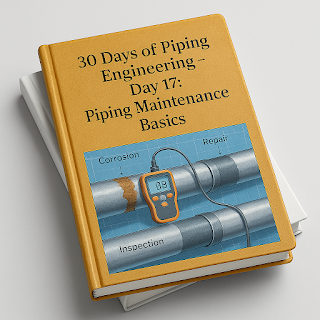30 Days of Piping Engineering – Day 17: Piping Maintenance Basics
Welcome to Day 17 of our 30 Days of Piping Engineering series! We’ve covered installation, design software, corrosion protection, and more. Today, we’re diving into piping maintenance basics—essential practices to keep your systems running smoothly and safely.
What Are Piping Maintenance Basics?
Piping maintenance involves regular inspections, repairs, and preventive measures to ensure a piping system remains operational, safe, and efficient over its lifespan. Here’s an overview:
- Routine Inspections:
- Check for leaks, corrosion, and wear at joints, valves, and supports.
- Use tools like ultrasonic thickness gauges to monitor pipe wall thinning due to corrosion.
- Preventive Maintenance:
- Cleaning: Flush systems to remove debris or scale buildup, especially in water or chemical lines.
- Lubrication: Apply lubricants to valve stems to ensure smooth operation, reducing wear on components.
- Coating Checks: Inspect and repair protective coatings to prevent corrosion, particularly in harsh environments.
- Repairs:
- Replace damaged sections, such as corroded pipes or worn gaskets, to prevent leaks.
- Tighten or adjust supports and hangers to maintain alignment and reduce stress, linking to our supports discussion.
- Monitoring Systems:
- Use sensors to track pressure, temperature, and flow, identifying issues early.
- Schedule downtime for major maintenance to avoid unexpected failures.
Effective maintenance extends system life, reduces downtime, and ensures safety, especially in critical applications like oil refineries or power plants.
Real-World Example
In a petrochemical plant, routine inspections found pitting corrosion on a gas line. The affected section was replaced during a planned shutdown, preventing a potential leak that could have halted production for weeks.
Did you know ?
The first formal piping maintenance programs emerged during the Industrial Revolution? As factories grew in the 1800s, engineers realized regular upkeep of steam lines was crucial to avoid explosions, shaping modern maintenance practices!
Your Day 17 Takeaway
Piping maintenance is key to reliability and safety—proactive care keeps your systems running without costly surprises. Tomorrow, we’ll explore piping safety and risk management—see you then!
